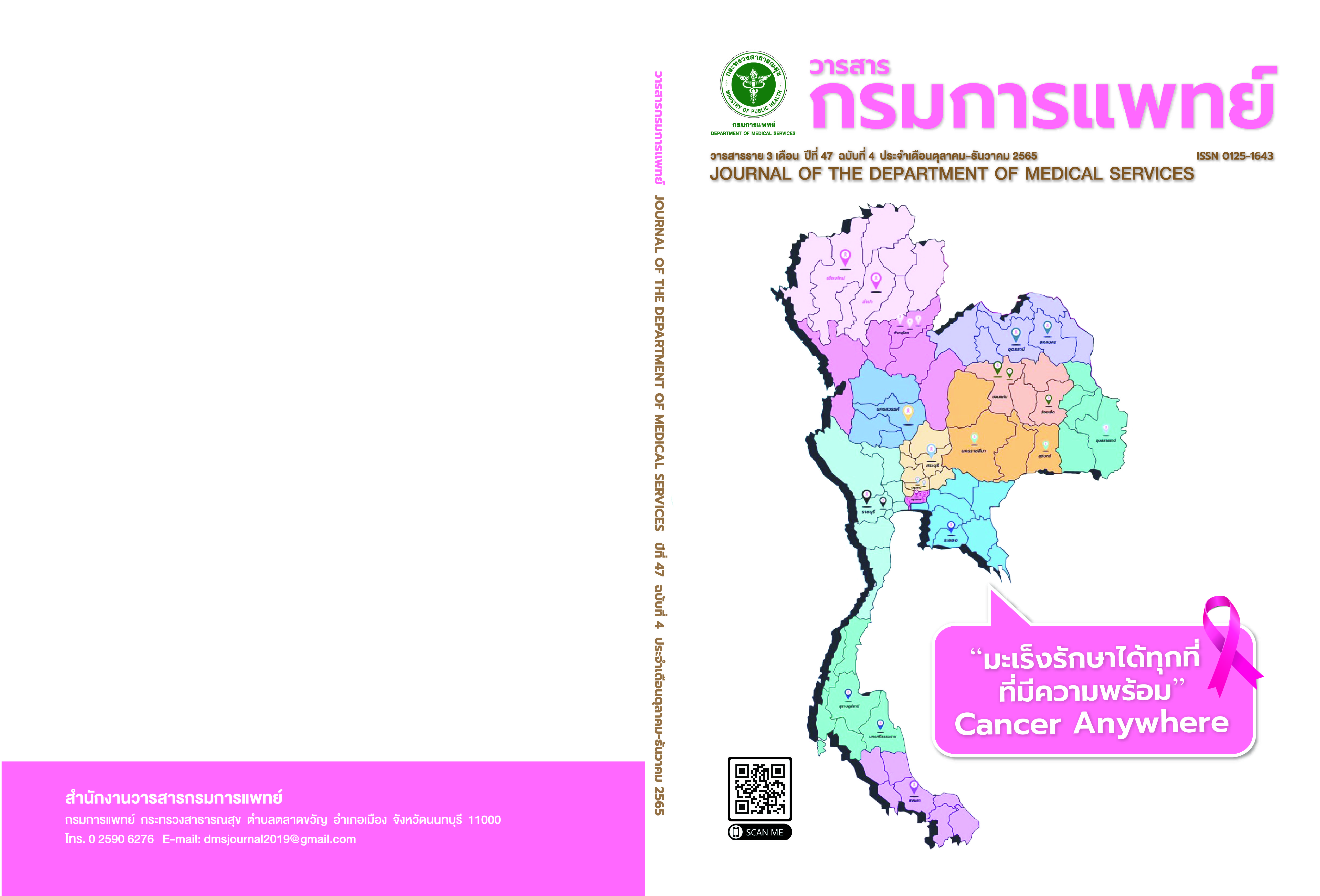Prevalence and Pattern of Third Molar Impaction Assessed from Orthopantomograms Among Patients at Rajavithi Hospital
Keywords:
Third molar, Pattern of third molar Impaction, Impacted toothAbstract
Background: Impacted teeth, if left untreated or under inappropriate treatment, have the potential to inducevarious complications. Objective: To determine the prevalence and pattern of impacted third molar by radiographicevaluation. Methods: This retrospective study was performed on patients who had an oral examination at theDental Department, Rajavithi Hospital between May 2017 and September 2017. Data were collected regarding thebaseline characteristics and orthopantomograms (OPG). Data were then analyzed using SPSS software version 22.0.The ethics committee of Rajavithi Hospital has reviewed and approved this study. Results: Among the 852 patientsincluded in the study, 71.8% were female with a mean age of 29.30 ± 11.20 years old. The pattern of the impactedthird molar, 3,107 teeth, was reviewed by radiographic evaluation. 65.9 percent were classified as impacted, of which33.5% were in the mandibular left third molar. The maxillary right and left third molars had impaction in level B at52.7% and 55.1%, vertical angular at 62.0% and 64.7%, respectively. The mandibular left and right third molars hadimpaction in level A at 57.9% and 63.9%, mesioangular impaction was 32.8% and 37.3%, and class II was at 85.5%and 87.6%, respectively. Conclusions: The prevalence of impacted third molar in patients has revealed a high rate,which is found in females more than males. The most vertically impacted site is level B in a maxillary third molar,while the mandibular third molar impacted site is mainly mesioangular, level A, and class II.
References
Hangsasoot C, Oral and maxillofacial. Yearbook Pub 1993.
Kitrueangphatchara K, Songwattana S. Factors associated withcomplications following impacted mandibular third molarremoval. Thai J Oral Maxillofac Surg 2015; 29:20-33.
Eshghpour M, Nezadi A, Moradi A. Pattern of mandibular thirdmolar impaction: A cross-sectional study in northeast of Iran.Niger J Clin Pract 2014; 17:673-7.
Wayne WD. Biostatistics: A foundation of analysis in the healthsciences. 6th ed. New York: John Wiley and Sons; 1995.
Hassan AH. Pattern of third molar impaction in a Saudipopulation.Clin Cosmet Investig Dent 2010; 2:109-13.
Yilmaz S, Adisen MZ, Misirlioglu M. Assessment of Third MolarImpaction Pattern and Associated Clinical Symptoms in a CentralAnatolian Turkish Population. Med Princ Pract 2016; 25:169-75.
Padhye MN, Dabir AV, Girotra CS. Pattern of mandibular thirdmolar impaction in the Indian population: a retrospectiveclinico-radiographic survey. Oral Surg Oral Med Oral PatholOral Radiol 2013; 116:161-6.
Quek SL, Tay CK, Tay KH, Toh SL, Lim KC. Pattern of third molarimpaction in a Singapore Chinese population: A retrospectiveradiographic survey. Int J Clin Oral Maxillofac Surg 2003; 32:548-52.
Anandumi K, Kalyanyama B, Moshy JR, Sohal KS, SimonEN. Pattern of impacted teeth among patients at MNH. JCraniomaxillofac Res 2022; 8:150-8.
Eshghpour M, Nezadi A, Moradi A, Shamsabadi RM, RezaeiNM, Nejat A. Pattern of mandibular third molar impaction: Across-sectional study in northeast of Iran. Niger J Clin Pract 2014;17:673-7.
Gisakis IG, Palamidakis FD, Farmakis ET, Kamberos G, KamberosS. Prevalence of impacted teeth in a Greek population. J InvestigClin Dent 2011; 2:102-9.
Zhi YH, Aziz CK, Haque S, Suriana W, Rahman WA, Alam MK.Prevalence of Impacted third molars by winter’s classifcationand pell & gregory’s classifcation on radiographic assessment inrelation to ABO blood group in orthodontic patients in HospitalUniversiti Sains Malaysia (HUSM). Int Med J 2019; 26:321-5.
Hatem M, Bugaighis I, Taher EM. Pattern of third molar impactionin Libyan population: A retrospective radiographic study. SaudiJ Dent Res 2016; 7:7-12.
Yilmaz S, Adisen MZ, Misirlioglu M, Yorubulut S. Assessment ofThird Molar Impaction Pattern and Associated Clinical Symptomsin a Central Anatolian Turkish Population. Med Princ Pract 2016;25:169-75.
Idris AM, Al-Mashraqi AA, Abidi NH, Vani NV, Elamin EI, KhubraniYH, et al. Third molar impaction in the Jazan Region: Evaluationof the prevalence and clinical presentation. Saudi J Dent Res2021; 33:194-200.
Hattab FN, Fahmy MS, Rawashedeh MA. Impaction status of thirdmolars in Jordanian students. Oral Surg Oral Med Oral PatholOral Radiol Endod 1995; 79:24-9.
Brown LH, Berkman S, Cohen D, Kaplan AL, Rosenberg M. Aradiological study of the frequency and distribution of impactedteeth. J Dent Assoc S Afr 1982; 37:627-30.
Haidar Z, Shalhoub SY. The incidence of impacted wisdom teethin Saudi community. Int J Oral Maxillofac Surg 1986; 15:569-71.
Morris CR, Jerman AC. Panoramic radiographic survey: A studyof embedded third molars. J Oral Surg 1972; 29:122-5.
Hashemipour MA, Tahmasbi-Arashlow M, Fahimi-Hanzaei F.Incidence of impacted mandibular and maxillary third molars:a radiographic study in a Southeast Iran population. Med OralPatol Oral Cir Bucal 2013; 18:140-5.
Kaomongkolgit R, Tantanapornkul W. Pattern of impacted thirdmolars in Thai population: Retrospective radiographic survey. JInt Dent Med Res 2017; 10:30-5.
Jaroń Aleksandra, Grzegorz T. The Pattern of MandibularThird Molar Impaction and Assessment of Surgery Diffculty: ARetrospective Study of Radiographs in East Baltic Population.Int J Environ Res Public Health 2021; 18:1-15.
Monaco G, Montevecchi M, Bonetti GA, Gatto MR, Checchi L.Reliability of panoramic radiography in evaluating thetopographic relationship between the mandibular canal andimpacted third molars. J Am Dent Assoc 2004; 135:312-8.
Obiechina AE, Arotiba JT, Fasola AO. Third molar impaction:evaluation of the symptoms and pattern of impaction ofmandibular third molar teeth in Nigerians. OdontostomatolTrop 2001; 24:22-5.
Downloads
Published
How to Cite
Issue
Section
License
Copyright (c) 2022 Department of Medical Services, Ministry of Public Health

This work is licensed under a Creative Commons Attribution-NonCommercial-NoDerivatives 4.0 International License.
บทความที่ได้รับการตีพิมพ์เป็นลิขสิทธิ์ของกรมการแพทย์ กระทรวงสาธารณสุข
ข้อความและข้อคิดเห็นต่างๆ เป็นของผู้เขียนบทความ ไม่ใช่ความเห็นของกองบรรณาธิการหรือของวารสารกรมการแพทย์



